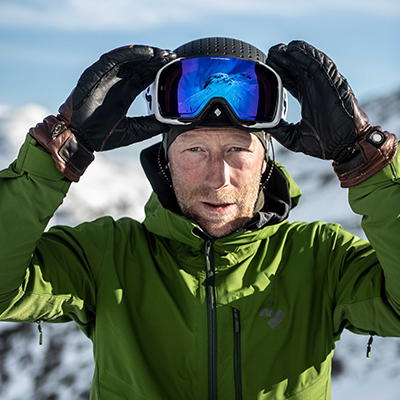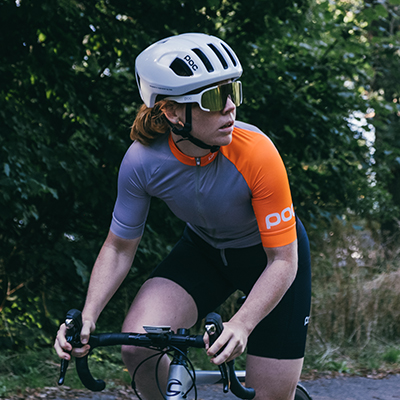Glasses
By Popularity
Outdoor glasses at eXXpozed
Why should sunglasses be worn?
On vacation, during sports or a longer stay in the fresh air, you must protect not only your skin but also your eyes. Looking directly into the sun can lead to vision problems and permanent eye damage after just a few seconds. But also indirect sunlight during long stays at the beach, outdoor sports or extended ski tours can cause permanent damage to the eyes. Tissue damage to the conjunctiva (conjunctivitis) and cornea (corneal inflammation) or long-term lens clouding (cataract) are just a few of the possible consequences. In this aspect, sports glasses increase safety, protect the eyes from impairment by UV radiation and ensure that the sun does not dazzle so much. Especially on our natural playground in the mountains, the radiation is particularly high and high-quality sunglasses are an essential accessory. Not only do sports glasses offer outdoor enthusiasts perfect protection for the eyes, but with fashionable designs and details they are visually an absolute eye-catcher. In addition to sports glasses, we also carry sunglasses and leisure glasses for urban adventures, ski goggles for the next mountain hut party, cycling glasses for off-road trails and, of course, eyewear accessories for proper care of the pieces.

Which glasses can be found in the eXXpozed range?
Goggles are designed for a wide variety of sports. Therefore, glacier goggles require different properties than fashionable sunglasses. Basically, you can choose between the following types of glasses in our store:
- Sports glasses: The all-rounders for sports use, can be used in many ways
- Bike eyewear: Protect against insects and flying dirt particles while riding, should be aerodynamic and well ventilated
- Mountain and hiking goggles: Should be very stable so that they can be quickly stowed in the backpack
- Glacier goggles: In terms of UV protection and stability, these goggles have to perform well, essential for clear vision in high mountains
- Running glasses: Due to the constant up and down movement, they have to be 100 percent secure and fit tightly
- Ski goggles: Offer protection from wind and should fit comfortably, there are models in different sizes and with interchangeable lenses
- Sunglasses: Goggles for everyday wear and sufficient UV protection
- Casual eyewear: Functionality is secondary here, what counts is the style
What do I need to consider when buying sunglasses?
Sunglasses are an important piece of outdoor equipment, so enough time should be invested in their selection. The decision should not be taken lightly and individual preferences should be taken into account. Therefore, when buying pay attention to the following characteristics:
- Fit
- UV protection
- Protection level and intended use
- Tint
We will try to explain all the listed criteria in more detail below with the help of a small buying guid
How should sports glasses fit?

First and foremost, sports glasses should fit snugly, be comfortable to wear and not slip. This prevents stray light from reaching the eyes, but the eyelashes should not touch the lenses. During sports you are constantly on the move and slipping sunglasses are only annoying. Nevertheless, the glasses should not press against the ears after prolonged wear. Optionally, there is the possibility to adjust the eyeglass temple or nose bridge individually. The field of vision at the sides should also not be restricted. Furthermore, the right material for lenses and frame should be chosen. The material of the lens must not splinter, should be stable, but at the same time bendable and flexible. This reduces the risk of injury, for example, in the event of a fall, since the glasses in a sense only give way instead of breaking. The lenses of the visual aid should therefore be made of plastic. To protect against scratches, an additional hard coating is recommended for lenses made of plastic. The frame should also minimize the risk of injury. Therefore, care should be taken not to choose materials made of glass or metal, for example. All in all, sports glasses should be unbreakable and lightweight so that all sporting activities can be mastered.
Which UV protection factor do I need?
In addition to visible light, the sun also emits invisible UV rays in the direction of the earth. UV-A and UV-B rays penetrate unhindered to the earth's surface, while UV-C rays are absorbed by the earth's atmosphere. This radiation is also present in the shade or on cloudy days, even if it is not visible. Sand, water and snow in particular reflect the sunlight and intensify its effect. So that our eyes are not continuously exposed to this stress, they must be protected at all times. This is guaranteed by the manufacturer with the UV radiation. If a pair of glasses is equipped with UV protection, it protects against invisible sun rays of wavelengths 280 to 380 nanometers. If a pair of glasses has a UV 400 Sigel, these filter UV rays up to a wavelength of 400 nanometers, which includes all UV-A and UV-B rays and offers 100% UV protection according to the EU directive.
What does the protection level mean and how many of them do exist?
First of all, protection level is not the same as UV protection. The protection category indicates the area of use or the intensity of irradiation for which a pair of sports glasses is suitable. The EU regulation thus standardizes the area of application and filter category. Depending on the protection level, sports glasses have different filters that absorb different amounts of light. A distinction is made between five different protection levels:
| Category | Tint | Light absorption | Intended use | ||||||||||||||||||||||||||||||||||||
|---|---|---|---|---|---|---|---|---|---|---|---|---|---|---|---|---|---|---|---|---|---|---|---|---|---|---|---|---|---|---|---|---|---|---|---|---|---|---|---|
| 0 | Clear or very bright | 0 - 20% | Protection from insects and wind, ideal for cloudy days and twilight | ||||||||||||||||||||||||||||||||||||
| 1 | Light to medium | 20 - 57% | Under overcast skies, slightly brightening and increasing contrast | ||||||||||||||||||||||||||||||||||||
| 2 | Dark | 57 - 82% | Typical solar radiation as on summer days in our latitudes | ||||||||||||||||||||||||||||||||||||
| 3 | Very dark | 82 - 92% | Suitable for winter sports, in the mountains or on the beach | ||||||||||||||||||||||||||||||||||||
| 4 | Extremely dark or
even mirrored |
92 - 97% | Ideal for stays in the high mountains or on glaciers, on the water or in the desert
(CAUTION: not suitable for road use) |

What does tinting do for me?
Tints are responsible for reducing the intensity of incident light and changing the spectral composition due to their color properties. But tints are perceived differently and vary from person to person. Personal perception therefore plays a major role. That is why you should take enough time and test out different options. The tint should be adapted to environmental conditions and lighting conditions and include the individual component. Based on the protection categories, ski goggles need a darker tint than regular sports goggles for bike excursions, jogging sessions or hiking. Especially when cycling and in traffic, it is important to avoid glasses with red tint, because red light waves are filtered out, which can make it extremely dangerous on the roads. Relatively new on the market are sports glasses with so-called photochromic lenses. These adapt automatically to light conditions within seconds and the lenses tint themselves automatically.
What does the CE mark stand for?
The CE mark must be affixed to all sunglasses sold within the EU. It indicates that the glasses meet generally applicable production safety requirements according to European standards. However, the CE symbol is not able to make a statement about the UV protection and the protection level of the sunglasses.
Our favorite topics: Cross country ski goggles | Glasses for kids | Prism glasses for climbing | Sweet Protection ski goggles | Sports glasses for men | Alpina sports glasses














